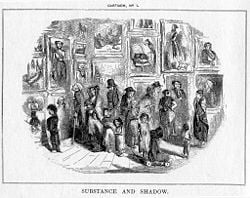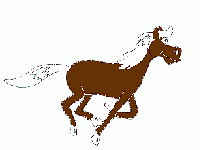Cartoon
The phrase cartoon refers to several forms of art, including humorous captioned illustrations, satirical political drawings, animated films, and full-scale drawings for various forms of fine art, such as frescos and tapestries. From fine art to political commentary and entertainment, cartoons have played an important role in shaping the world as we know it.
Cartoons in Fine Art
In its original meaning, a cartoon (from the Italian cartone, meaning "big paper") is a full-size drawing made on paper as a full size study for artwork. Cartoons were first used for fresco painting, a technique involving the application of pigment to a wet lime plaster wall, during the sixteeth century. Once the composition is drawn on paper, it is then transfered to the plaster wall by one of two techniques. The artist may use a tool to trace over the design, indenting the image into the plaster, or a perforating tool may be used, after which the charcol dust is applied to mark the lines of the composition.
Cartoons by painters such as Raphael and Leonardo da Vinci are proudly displayed in musuems around the world. A world-renowned collection of cartoons for tapestries byPeter Paul Rubens, one of the most famous artists of the seventeeth century, is displayed in the John and Mable Ringling Museum of Art in Sarasota, Florida.
Editorial Cartoons
An editorial cartoon, also known as a political cartoon, is an illustration or comic strip containing a political or social message. Editorial cartoons first made an emergence during the Protestant Reformation in Germany, in the early 1500's. In order to disseminate his ideas to a largely illiterate population, Martin Luther, the leader of the Reformation, turned to the printed image. Images protesting the actions of the powerful Catholic Church were distributed on broadsheet posters and illustrated pamphlets, and proved an effective means of reaching a large portion of the population.[1]
In the United States, the first political cartoon was printed by Ben Franklin in The Pennsylvania Gazette on May 9, 1754. This well known image features a segmented snake with the segments representing colonial governments, and the caption "Join, or Die" below. Based on the popular superstition that a severed snake could be made whole again if the pieces were placed together, the cartoon urged colonial governments to unite during the French and Indian War. The image was reprinted by newspapers throughout the colonies.
It was not until 1843 that the term "cartoon" was used to refer to anything but preliminary sketches for fine art. The phrase was coined by the British magazine 'Punch', a magazine well known for its satirical drawings. At the time, the Houses of Parliament were being rebuilt after a fire, and artists were encouraged to submit preliminary drawings, or cartoons, to help select new paintings and murals. A series of drawings given the title "cartoons" (including John Leech's "Cartoon, No.1: Substance and Shadow") used sarcasm to attack the government's expenditure of money on needless opulence while the poor went hungry. The term "cartoon" stuck as a description of pictoral satire, and eventually expanded to include any form of humorous drawing.[2]
Modern editorial cartoons can be found in most newspapers, and many radical or minority issue editorial cartoonists who might never have been published have established a presence on the internet. Editorial cartoons can be very diverse, but there is a certain established style among most of them. Most editorial cartoons use visual metaphors and caricatures to explain complicated political situations, and thus sum up a current event with a humorous or emotional picture. Some common visual metaphors are the donkey and elephant (symbolizing American political parties), the beaver (symbolizing Canada), the lion (symbolizing Great Britian), and the bear (symbolizing Russia). Although their style, technique or viewpoints may differ, editorial cartoonists all draw attention to important social and political issues.
By their very nature, editorial and political cartoons spark controversy. Cartoons have been used to depict a wide range of political, religious, and social viewpoints, and often touch upon topics that may be sensitive. While such cartoons can often be a positive influence for change, they can also exacerbate exsisting tensions.
Gag Cartoons and Comic Strips
Modern gag cartoons are found in magazines, newspapers, and greeting cards, and generally consist of a single drawing with a caption immediately beneath or a speech balloon. Well-known gag cartoonists include James Thurber, Gary Larson, and Peter Arno.
Comic strips, also known as "strip cartoons" in the United Kingdom, are found daily on their own page in newspapers worldwide, and are usually a short series of cartoon illustrations in sequence. In the United States they are commonly referred to as "comics" or "funnies". Although humor is the most prevalent subject matter, adventure and drama are also represented in this medium. Most comic strips are stand-alone, but some are serial in nature, with a story line that is continued daily or weekly. Noteworthy comic strip cartoonists Charles Schulz (Peanuts), Bill Watterson (Calvin and Hobbes), Scott Adams (Dilbert), Mort Walker (Beetle Bailey and Hi and Lois), Steve Bell (If...).
Cartoons in Film
One of the most common modern usages of the phrase "cartoon" refers to animated television, movies, and shorts. Although the term can be applied to any animated presentation, it is most often used in reference to programs for children, featuring anthropomorphized animals, superheroes, the adventures of child protagonists, and other similar themes.
Winsor McCay, considered "the father of the animated cartoon", produced a landmark animated cartoon in 1914 titled "Gertie the Dinosaur". This cartoon was the first to feature a character developed specifically for animation, and showed the true potential of the medium. Legendary Warner Bros. animation director Chuck Jones is quoted as saying that "the two most important people in animation are Winsor McCay and Walt Disney, and I'm not sure which should go first."[3] Five years later, Otto Messmer created the world famous Felix the Cat.
One of the most famous early cartoons, and the first to incorporate sound, is Walt Disney's "Steamboat Willie". Released in 1928, this was the first feature performance of Mickey Mouse. Disney went on to create an animation empire, encouraging his animators to portray characters with more realistic movement, and creating breakthrough masterpieces like "Snow White" and "Fantasia".
In 1930, Warner Bros.' "Looney Tunes" was founded by Disney animators Hugh Harman and Rudy Ising (both of whom left three years later to form the MGM cartoon studio). Warner Bros. directors Tex Avery and Bob Clampett began the tradition of exaggerated slapstick comedy in cartoons that still persists today. Characters like Bugs Bunny and Daffy Duck exemplify not only the talent of individual animators, but also their ability to collaborate in a studio-based, assembly-line type system.[4]
Until the late 1940's, cartoons were shown in movie theaters. It was typical for theaters of the day to show two full-length films seperated by a cartoon and newsreel; many "golden era" cartoons from the 1930's through the 1950's were originally designed to be seen on the big screen. Once television started to grow in popularity, cartoons began to be produced for the small screen. Disney was one of the first cartoon studios to regularly air cartoons, including them in live action programs like 'The Mickey Mouse Club'. In the 1950's, United Productions of America (UPA), a studio formed by ex-Disney animators, created a simple, less theatrical approach to animation. Instead of natural colors and detailed background, the UPA animators used bold colors, abstract renditions of clouds and trees, and limited movement. As more cartoons were produced exclusively for television, other animators adopted the time and money saving techniques of the UPA animators, though many lost UPA's aesthetics in the process.[5]
Two of the most popular and longest running cartoon shows are 'The Flintstones', which premiered in 1960, and 'The Simpsons', which premiered in 1989. Cartoons continue to have success as full length movies; modern techniques in computer animation allow the cartoonist to create images that would not be possible with traditional animating processes. Movies like 'Toy Story' (1995) and 'Finding Nemo' (2003) are examples of computer generated imagery, or CGI. The use of CGI technology does not, contrary to what one might believe, mean less work for the animators. 'Toy Story', the first completely CGI-animated feature, took four years to complete; the same amount of time it took for Disney animators to complete 'Snow White and the Seven Dwarfs'.[6]
Cartoons have long been the subject of controversy in the areas of merchandizing and violence, particularly since the predominant audience of cartoons is children. In the 1980's, cartoons like 'Strawberry Shortcake' and 'He-Man' were created around exsisting products, for which the television programs were little more than extended commercials.[7]
There are also a growing number of adult-themed cartoon shows, usually referred to as "adult cartoons". Certain styles of animations, such as japanese 'anime', are not generally referred to as "cartoons".
Notes
- ↑ Part I: A Brief History of Political Cartoons. The University of Virginia. Retrieved November 28, 2006.
- ↑ History of the Cartoon. Punch Magazine. Retrieved November 28, 2006.
- ↑ Background About Winsor McCay. Cartoonist Group. Retrieved November 29, 2006.
- ↑ Crandol. Animation History, Winsor McCay, Max Fleischer. Digital Media FX. Retrieved November 29, 2006.
- ↑ Cartoons. The Museum of Broadcast Communications. Retrieved November 29, 2006.
- ↑ Animation. Adacamy of Motion Picture Arts and Sciences. Retrieved November 29, 2006.
- ↑ Cartoons. The Museum of Broadcast Communications. Retrieved November 29, 2006.
External links
- CartoonStock database of gag, editorial and historic cartoons
- Punch website's history of cartoons
- New Yorker's Cartoon Bank
- Daryl Cagle's Professional Cartoonists Index
- Don Markenstein's Toonopedia
- Big Cartoon Database
- Golden Age of Cartoons
- A free cartoons directory : The Cartoon Spot
- Toon-Cycle: Cartoon community and media resources
- Russian animated cartoons and World Day of Animated cartoon
- British Cartoon Archive has a database of over 100,000 editorial cartoons published in the British press
- Using editorial cartoons in the classroom Sources, analysis, interpretation (mostly English with some German)
- Goldbrick Gallery: A daily collection of the latest masterstrokes from the sharpest pens in Editorial Cartooning.
Credits
New World Encyclopedia writers and editors rewrote and completed the Wikipedia article in accordance with New World Encyclopedia standards. This article abides by terms of the Creative Commons CC-by-sa 3.0 License (CC-by-sa), which may be used and disseminated with proper attribution. Credit is due under the terms of this license that can reference both the New World Encyclopedia contributors and the selfless volunteer contributors of the Wikimedia Foundation. To cite this article click here for a list of acceptable citing formats.The history of earlier contributions by wikipedians is accessible to researchers here:
The history of this article since it was imported to New World Encyclopedia:
Note: Some restrictions may apply to use of individual images which are separately licensed.


